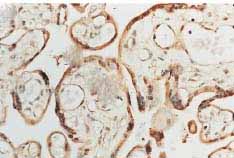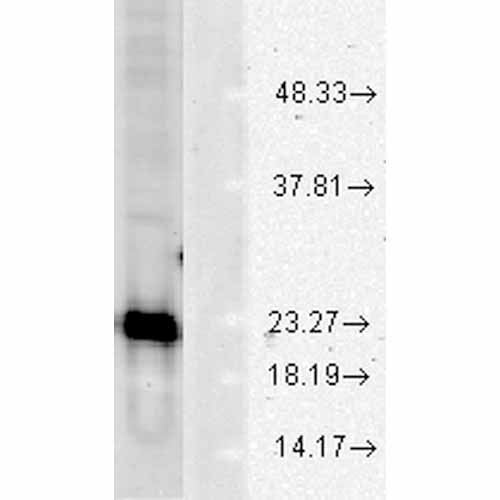SOD (Cu/Zn) Antibody
- SPECIFICATION
- CITATIONS
- PROTOCOLS
- BACKGROUND

Application
| WB, IHC, IP |
|---|---|
| Primary Accession | P00441 |
| Other Accession | NP_000445.1 |
| Host | Rabbit |
| Reactivity | Insect, Human, Mouse, Rat, Rabbit, Hamster, Monkey, Pig, Bovine, Xenopus, Dog, Fish, Sheep |
| Clonality | Polyclonal |
| Description | Rabbit Anti-Human SOD (Cu/Zn) Polyclonal |
| Target/Specificity | Detects ~23kDa (human) and ~19kDa (other species). |
| Other Names | Superoxide dismutase1 Antibody, ALS1 Antibody, IPOA Antibody, SOD1 Antibody, SOD2 Antibody, SODC Antibody |
| Immunogen | Human Cu/Zn SOD |
| Purification | Protein A Purified |
| Storage | -20ºC |
| Storage Buffer | PBS pH7.0, 50% glycerol, 0.09% sodium azide |
| Shipping Temperature | Blue Ice or 4ºC |
| Certificate of Analysis | 0.2 µg/ml of SPC-116 was sufficient for detection of Cu/Zn SOD in 20 µg of HeLa cell lysate by colorimetric immunoblot analysis using Goat anti-rabbit IgG:AP as the secondary antibody. |
| Cellular Localization | Cytoplasm |

Thousands of laboratories across the world have published research that depended on the performance of antibodies from Abcepta to advance their research. Check out links to articles that cite our products in major peer-reviewed journals, organized by research category.
info@abcepta.com, and receive a free "I Love Antibodies" mug.
Provided below are standard protocols that you may find useful for product applications.
Background
Superoxide dismutase (SOD) is an endogenously produced intracellular enzyme present in almost every cell in the body (3). It works by catalyzing the dismutation of the superoxide radical O2ˉ to O2 and H2O2, which are then metabolized to H2O and O2 by catalase and glutathione peroxidase (2,5). In general, SODs play a major role in antioxidant defense mechanisms (4). There are two main types of SOD in mammalian cells. One form (SOD1) contains Cu and Zn ions as a homodimer and exists in the cytoplasm. The two subunits of 16 kDa each are linked by two cysteines forming an intra-subunit disulphide bridge (3). The second form (SOD2) is a manganese containing enzyme and resides in the mitochondrial matrix. It is a homotetramer of 80 kDa. The third form (SOD3 or EC-SOD) is like SOD1 in that it contains Cu and Zn ions, however it is distinct in that it is a homotetramer, with a mass of 30 kDA and it exists only in the extra-cellular space (7). SOD3 can also be distinguished by its heparin-binding capacity (1).
References
1. Adachi T., et al. (1992). Clin. Chim. Acta. 212: 89-102.
2. Barrister J.V., et al. (1987). Crit. Rev. Biochem. 22:111-180.
3. Furukawa Y., O’Halloran T. (2006). Antioxidants & Redo Signaling. Vol 8, No 5,6.
4. Gao B., et al. (2003). Am J Physiol Lung Cell Mol Physiol 284: L917-L925.
5. Hassan H.M. (1988). Free Radical Biol. Med. 5: 377-385.
6. Kurobe N., et al. (1990) Biomedical Research. 11: 187-194
7. Wispe J.R., et al. (1989) BBA. 994: 30-36.
8. Xiao-Hong Liu., et al. (1993) Brain Research. 625: 29-37.
If you have used an Abcepta product and would like to share how it has performed, please click on the "Submit Review" button and provide the requested information. Our staff will examine and post your review and contact you if needed.
If you have any additional inquiries please email technical services at tech@abcepta.com.













 Foundational characteristics of cancer include proliferation, angiogenesis, migration, evasion of apoptosis, and cellular immortality. Find key markers for these cellular processes and antibodies to detect them.
Foundational characteristics of cancer include proliferation, angiogenesis, migration, evasion of apoptosis, and cellular immortality. Find key markers for these cellular processes and antibodies to detect them. The SUMOplot™ Analysis Program predicts and scores sumoylation sites in your protein. SUMOylation is a post-translational modification involved in various cellular processes, such as nuclear-cytosolic transport, transcriptional regulation, apoptosis, protein stability, response to stress, and progression through the cell cycle.
The SUMOplot™ Analysis Program predicts and scores sumoylation sites in your protein. SUMOylation is a post-translational modification involved in various cellular processes, such as nuclear-cytosolic transport, transcriptional regulation, apoptosis, protein stability, response to stress, and progression through the cell cycle. The Autophagy Receptor Motif Plotter predicts and scores autophagy receptor binding sites in your protein. Identifying proteins connected to this pathway is critical to understanding the role of autophagy in physiological as well as pathological processes such as development, differentiation, neurodegenerative diseases, stress, infection, and cancer.
The Autophagy Receptor Motif Plotter predicts and scores autophagy receptor binding sites in your protein. Identifying proteins connected to this pathway is critical to understanding the role of autophagy in physiological as well as pathological processes such as development, differentiation, neurodegenerative diseases, stress, infection, and cancer.



